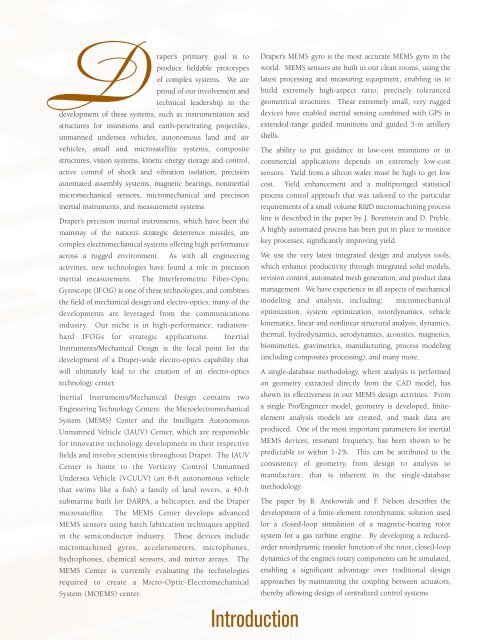1998 - Draper Laboratory
1998 - Draper Laboratory
1998 - Draper Laboratory
- No tags were found...
Create successful ePaper yourself
Turn your PDF publications into a flip-book with our unique Google optimized e-Paper software.
<strong>Draper</strong>’s primary goal is to <strong>Draper</strong>’s MEMS gyro is the most accurate MEMS gyro in theproduce fieldable prototypes world. MEMS sensors are built in our clean rooms, using theof complex systems. We are latest processing and measuring equipment, enabling us toproud of our involvement and build extremely high-aspect ratio, precisely tolerancedtechnical leadership in the geometrical structures. These extremely small, very ruggeddevelopment of these systems, such as instrumentation andstructures for munitions and earth-penetrating projectiles,unmanned undersea vehicles, autonomous land and airvehicles, small and microsatellite systems, compositestructures, vision systems, kinetic energy storage and control,active control of shock and vibration isolation, precisionautomated assembly systems, magnetic bearings, noninertialmicromechanical sensors, micromechanical and precisioninertial instruments, and measurement systems.<strong>Draper</strong>’s precision inertial instruments, which have been themainstay of the nation’s strategic deterrence missiles, arecomplex electromechanical systems offering high performanceacross a rugged environment. As with all engineeringactivities, new technologies have found a role in precisioninertial measurement. The Interferometric Fiber-OpticGyroscope (IFOG) is one of these technologies, and combinesdevices have enabled inertial sensing combined with GPS inextended-range guided munitions and guided 5-in artilleryshells.The ability to put guidance in low-cost munitions or incommercial applications depends on extremely low-costsensors. Yield from a silicon wafer must be high to get lowcost. Yield enhancement and a multipronged statisticalprocess control approach that was tailored to the particularrequirements of a small volume R&D micromachining processline is described in the paper by J. Borenstein and D. Preble.A highly automated process has been put in place to monitorkey processes, significantly improving yield.We use the very latest integrated design and analysis tools,which enhance productivity through integrated solid models,revision control, automated mesh generation, and product datamanagement. We have experience in all aspects of mechanicalthe field of mechanical design and electro-optics; many of the modeling and analysis, including: micromechanicaldevelopments are leveraged from the communicationsindustry. Our niche is in high-performance, radiationhardoptimization, system optimization, rotordynamics, vehiclekinematics, linear and nonlinear structural analysis, dynamics,IFOGs for strategic applications. Inertial thermal, hydrodynamics, aerodynamics, acoustics, magnetics,Instruments/Mechanical Design is the focal point for thedevelopment of a <strong>Draper</strong>-wide electro-optics capability thatwill ultimately lead to the creation of an electro-opticstechnology center.Inertial Instruments/Mechanical Design contains twoEngineering Technology Centers: the MicroelectromechanicalSystem (MEMS) Center and the Intelligent AutonomousUnmanned Vehicle (IAUV) Center, which are responsiblefor innovative technology development in their respectivefields and involve scientists throughout <strong>Draper</strong>. The IAUVCenter is home to the Vorticity Control UnmannedUndersea Vehicle (VCUUV) (an 8-ft autonomous vehiclethat swims like a fish) a family of land rovers, a 40-ftsubmarine built for DARPA, a helicopter, and the <strong>Draper</strong>microsatellite. The MEMS Center develops advancedMEMS sensors using batch fabrication techniques appliedin the semiconductor industry. These devices includemicromachined gyros, accelerometers, microphones,hydrophones, chemical sensors, and mirror arrays. TheMEMS Center is currently evaluating the technologiesrequired to create a Micro-Optic-ElectromechanicalSystem (MOEMS) center.biomimetics, gravimetrics, manufacturing, process modeling(including composites processing), and many more.A single-database methodology, where analysis is performedon geometry extracted directly from the CAD model, hasshown its effectiveness in our MEMS design activities. Froma single Pro/Engineer model, geometry is developed, finiteelementanalysis models are created, and mask data areproduced. One of the most important parameters for inertialMEMS devices, resonant frequency, has been shown to bepredictable to within 1-2%. This can be attributed to theconsistency of geometry, from design to analysis tomanufacture, that is inherent in the single-databasemethodology.The paper by B. Antkowiak and F. Nelson describes thedevelopment of a finite-element rotordynamic solution usedfor a closed-loop simulation of a magnetic-bearing rotorsystem for a gas turbine engine. By developing a reducedorderrotordynamic transfer function of the rotor, closed-loopdynamics of the engine’s rotary components can be simulated,enabling a significant advantage over traditional designapproaches by maintaining the coupling between actuators,thereby allowing design of centralized control systems.Introduction
















